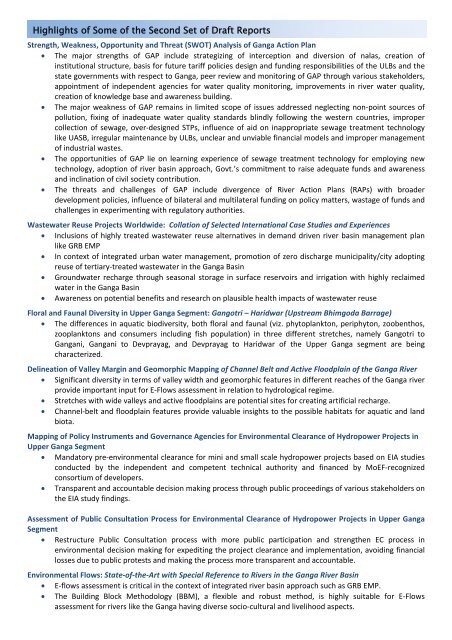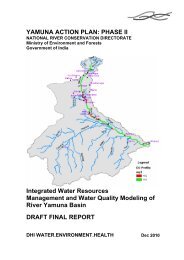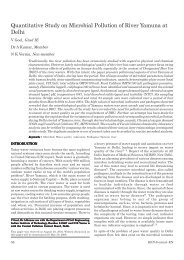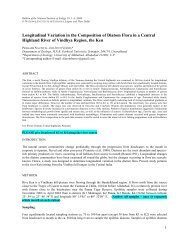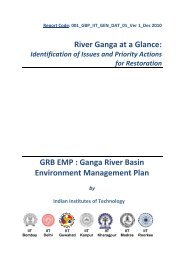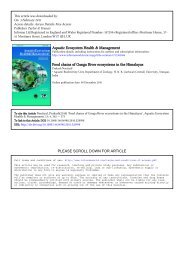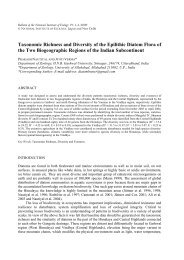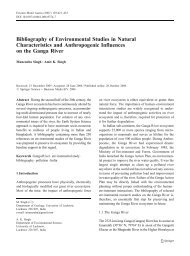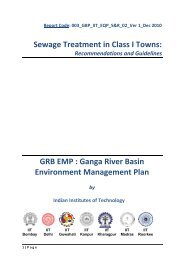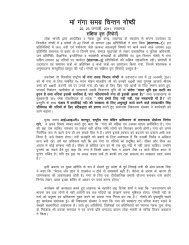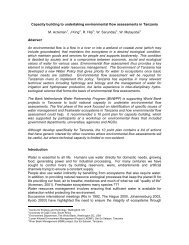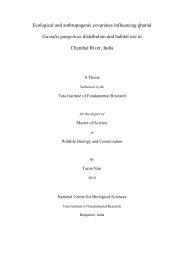GRBMP 2nd Newsletter_Final.pdf - GANGAPEDIA
GRBMP 2nd Newsletter_Final.pdf - GANGAPEDIA
GRBMP 2nd Newsletter_Final.pdf - GANGAPEDIA
You also want an ePaper? Increase the reach of your titles
YUMPU automatically turns print PDFs into web optimized ePapers that Google loves.
Highlights of Some of the Second Set of Draft Reports<br />
Strength, Weakness, Opportunity and Threat (SWOT) Analysis of Ganga Action Plan<br />
The major strengths of GAP include strategizing of interception and diversion of nalas, creation of<br />
institutional structure, basis for future tariff policies design and funding responsibilities of the ULBs and the<br />
state governments with respect to Ganga, peer review and monitoring of GAP through various stakeholders,<br />
appointment of independent agencies for water quality monitoring, improvements in river water quality,<br />
creation of knowledge base and awareness building.<br />
The major weakness of GAP remains in limited scope of issues addressed neglecting non‐point sources of<br />
pollution, fixing of inadequate water quality standards blindly following the western countries, improper<br />
collection of sewage, over‐designed STPs, influence of aid on inappropriate sewage treatment technology<br />
like UASB, irregular maintenance by ULBs, unclear and unviable financial models and improper management<br />
of industrial wastes.<br />
The opportunities of GAP lie on learning experience of sewage treatment technology for employing new<br />
technology, adoption of river basin approach, Govt.’s commitment to raise adequate funds and awareness<br />
and inclination of civil society contribution.<br />
The threats and challenges of GAP include divergence of River Action Plans (RAPs) with broader<br />
development policies, influence of bilateral and multilateral funding on policy matters, wastage of funds and<br />
challenges in experimenting with regulatory authorities.<br />
Wastewater Reuse Projects Worldwide: Collation of Selected International Case Studies and Experiences<br />
Inclusions of highly treated wastewater reuse alternatives in demand driven river basin management plan<br />
like GRB EMP<br />
In context of integrated urban water management, promotion of zero discharge municipality/city adopting<br />
reuse of tertiary‐treated wastewater in the Ganga Basin<br />
Groundwater recharge through seasonal storage in surface reservoirs and irrigation with highly reclaimed<br />
water in the Ganga Basin<br />
Awareness on potential benefits and research on plausible health impacts of wastewater reuse<br />
Floral and Faunal Diversity in Upper Ganga Segment: Gangotri – Haridwar (Upstream Bhimgoda Barrage)<br />
The differences in aquatic biodiversity, both floral and faunal (viz. phytoplankton, periphyton, zoobenthos,<br />
zooplanktons and consumers including fish population) in three different stretches, namely Gangotri to<br />
Gangani, Gangani to Devprayag, and Devprayag to Haridwar of the Upper Ganga segment are being<br />
characterized.<br />
Delineation of Valley Margin and Geomorphic Mapping of Channel Belt and Active Floodplain of the Ganga River<br />
Significant diversity in terms of valley width and geomorphic features in different reaches of the Ganga river<br />
provide important input for E‐Flows assessment in relation to hydrological regime.<br />
Stretches with wide valleys and active floodplains are potential sites for creating artificial recharge.<br />
Channel‐belt and floodplain features provide valuable insights to the possible habitats for aquatic and land<br />
biota.<br />
Mapping of Policy Instruments and Governance Agencies for Environmental Clearance of Hydropower Projects in<br />
Upper Ganga Segment<br />
Mandatory pre‐environmental clearance for mini and small scale hydropower projects based on EIA studies<br />
conducted by the independent and competent technical authority and financed by MoEF‐recognized<br />
consortium of developers.<br />
Transparent and accountable decision making process through public proceedings of various stakeholders on<br />
the EIA study findings.<br />
Assessment of Public Consultation Process for Environmental Clearance of Hydropower Projects in Upper Ganga<br />
Segment<br />
Restructure Public Consultation process with more public participation and strengthen EC process in<br />
environmental decision making for expediting the project clearance and implementation, avoiding financial<br />
losses due to public protests and making the process more transparent and accountable.<br />
Environmental Flows: State‐of‐the‐Art with Special Reference to Rivers in the Ganga River Basin<br />
E‐flows assessment is critical in the context of integrated river basin approach such as GRB EMP.<br />
The Building Block Methodology (BBM), a flexible and robust method, is highly suitable for E‐Flows<br />
assessment for rivers like the Ganga having diverse socio‐cultural and livelihood aspects.


